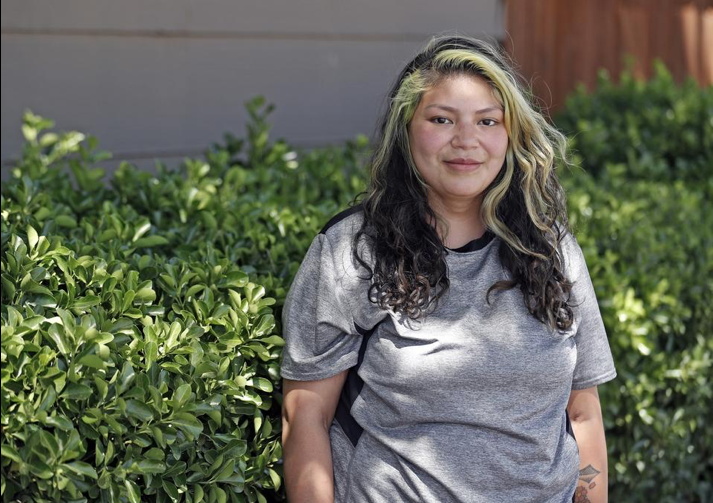
Lillie Gonzales could barely walk without the assistance of a cane when she went to see Dr. Matthew Ferguson, an orthopedic surgeon with the Texas Tech Physicians Orthopedic Clinic.
She’d been diagnosed with lupus and rheumatoid arthritis and the medications to control the pain caused by each of them unbeknown to Gonzales, began deteriorating a piece of the bone in her knee.
A few months after the initial consultation, Ferguson performed a partial knee transplant using BioUni OATS instruments and technique provided by a company called Anthrex. The procedure was the first of its kind performed in Lubbock.
Photos from before her surgery on March 22 show an evidently deteriorated half of a knee bone, Ferguson said as he pointed out pre- and post-operation photos. The condition is common in people at least 50 to 60 years old.
But Gonzales is 23.
Her knee problems started about four years ago. Gonzales was a new mom, fresh out of high school when she started feeling the aches of lupus.
Providers prescribed her 800 milligram Ibuprofen tablets for the pain. The recommended dose wasn’t doing enough and she was growing more frustrated at not being able to hold her then-5 month old son, so she tried taking more and started exceeding the recommended dosage. In the process, she was unknowingly damaging her kidney.
“I couldn’t control my pain and I didn’t understand why I wasn’t able to carry him,” Gonzales said of her oldest son, Jessie Gomez, now 4.
One day, she’d had enough and checked into the hospital, Gonzales said. She stayed for two weeks and was given a steroid to try to help her pain.
She had pain in both of her knees and her hip, she said. It hurt to walk. The pain was too much to stand. She was disappointed.
“I thought I was getting my lupus under control,” Gonzales said. “I was really sad.”
The pain got to be too much for her to continue physical therapy, so she quit and her doctor sent her to a surgeon.
“She sent me to the orthopedic surgeon and they did X-rays and that’s how they found out the steroid had basically deteriorated the bones in my (knee) joint,” Gonzales said.
A steroid called Prednisone that she’d been given to control the autoimmune disease started suppressing her immune system, Ferguson said.
“It kind of attacks,” he said. “It causes the underlying bone and the joints to collapse.”
Her bone was ulcerated, Ferguson said.
Had she known the extent of the damage it was causing inside her body, Gonzales said, she just would not have taken it.
By the time she got to Ferguson, the damage was done.
The initial consultations happened in late 2017. There was really no way around the knife.
Gonzales was concerned about being able to provide car for Gomez and her 2-year-old son James Torres. Surgery was inevitable, but the less she needed, the better for their sake.
Gonzales didn’t want anything artificial in her body. So Ferguson told her about a relatively new procedure involving a partial knee replacement with a cadaver bone, a technique introduced in 2016. The fix is expected to last at least 30 to 40 years, maybe longer. Gonzales agreed to it.

Ferguson performed a knee scope in February and cleared out the unattached cartilage in Gonzales’s knee. It also gave him and his team a chance to assess the damage and start making plans for the procedure.
Gonzales could feel the difference after that scope.
She could bend it more easily and walk better, she said. But there was more surgery to come.
She thought Ferguson was joking when he mentioned his team was going to run a practice session the week before she was to have surgery.
But the process is tedious and since it’s a new procedure, Ferguson wanted to be sure the technique was perfected before performing it on Gonzales.
Ferguson and his team had to arrange for the delivery of an available fresh cadaver bone. The team, including the Anthrex representatives, conducted a run through, which included practicing cutting the cadaver piece to the exact measurements to be implanted in Gonzales’s knee.
He was confident and Gonzales was excited for the anticipated relief but they hit a hiccup in the days before the surgery when her insurance denied her request for coverage of the procedure. This posed problems with the cadaver because it had an expiration date - the day after the scheduled surgery.
The hiccup was resolved the night before the scheduled date and the procedure went forward the next morning free of cost to Gonzales.
It’s been almost two months since the surgery and Gonzales is moving around a lot better, though not completely pain-free. She occasionally still uses her cane but, she said, she’s able to chase after her kids a little faster now.

“All I wanted to do was be able to get on the floor with my kids and play,” Gonzales said. “I wanted to run after them. I’m only 23.”
She can do more than she used to, she said, which is a relief. But more surgery on her hip and possibly her other knee is inevitably in her future. For now, though, she’s doing her best to enjoy the relief and she’s trying to do more with her kids.
Full story provided by: http://www.lubbockonline.com/news/
